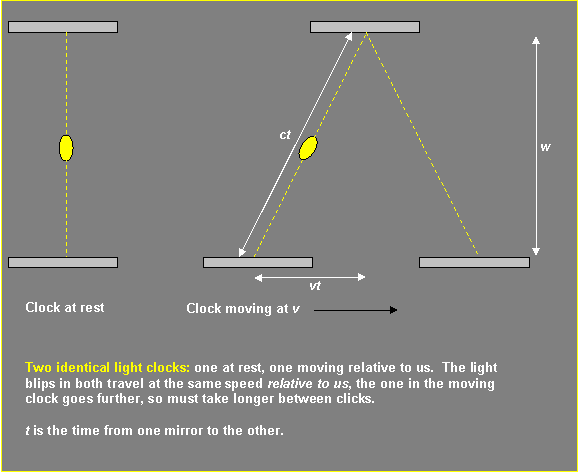Ever feel like time moves very quickly and sometimes very slowly? Like how the hours fly by when you're hanging out with a close friend, or how seconds drag on endlessly when you're stuck in traffic on a hot day? But you can't actually speed time up or slow it down -it always flows at the same rate, right?
Albert Einstein didn't think so. His idea was that, theoretically, the closer we come to traveling at the speed of light (186,000 miles per second), the more time would appear to slow down for us from the perspective of someone who, in relation to us, was not moving. He called the slowing of time due to motion time dilation.
Imagine you're standing on Earth holding a clock. Your friend is in a rocket zooming past you at nearly 186,000 miles per second. Your friend is also holding a clock. If you could see your friend's clock, you'd notice that it seems to be moving a lot more slowly than yours. Your friend, on the other hand, thinks the clock in the rocket is moving just fine, and it's your clock that seems to be moving more slowly. Sound confusing? Well, remember, it took Einstein years to figure this out, and he was pretty smart (see Genius Among Geniuses).
The twin paradox
Einstein came up with an example to show the effects of time dilation that he called the "twin paradox." It's a lot like the Time Traveler game you just played. Let's try it out with a pair of pretend twins, Al and Bert, both of whom are 10 years old in their highly futuristic universe.
Al's parents decide to send him to summer camp in the Alpha-3 star system, which is 25 light-years away (a light-year is the distance light travels in a year). Bert doesn't want to go and stays home on Earth. So Al sets out on his own. Wanting him to get there as quickly as possible, his parents pay extra and send him at 99.99 percent the speed of light.
The trip to the star and back takes 50 years. What happens when Al returns? His twin brother is now 60 years old, but Al is only 10 and a half. How can this be? Al was away for 50 years but only aged by half a year. Has Al just discovered the fountain of youth?
Not at all. Al's trip into space lasted only a half year for him, but on Earth 50 years passed. Does this mean that Al can live forever? Nope. He may have aged by only half a year in the time it took 50 years to pass on Earth, but he also only lived half a year. And since time can slow down but never goes backwards, there's no way he could grow younger.
http://www.pbs.org/wgbh/nova/einstein/hotsciencetwin/index.html
_______________________________________________
"One second is defined as 'the duration of 9192631770 periods of the radiation corresponding to the transition between the two hyperfine levels of the ground state of the caesium 133 atom'..."
http://en.wikipedia.org/wiki/Second
Now imagine, instead of a vibrating 'caesium 133 atom', we have a beam of light bouncing back and forth between two mirrors within a vertical tube. Now let's say, for the sake of argument, that it takes precisely 'one second' for the light beam to reach the top mirror (tick), reflect off it, reverse and reach the bottom mirror (tock).
Now let's say the light tube, or 'light clock', is resting on a flatbed train car, and on the flatbed is an observer who we will call "Observer A". To Observer A, who is moving along with the train and is therefore 'at rest' with respect to it, the light beam simply travels from the bottom of the tube *vertically* to the top of the tube and then straight back down again. From the relationship, speed equals distance over time, we get time equals distance over speed. So this is then how Observer A defines time (t=distance/speed). Important to note here is that light travels at the SAME SPEED for ALL observers.
Now let's say there is an observer B standing on the embankment alongside the train watching it pass by. From this observer's point of view, or frame of reference, the light beam does NOT simply travel vertically up and down. Rather, it travels on a slanted or diagonal path since the train is in motion, let's say from left to right as Observer B sees it. Now since the light beam travels a diagonal path between tick and tock, again, from OB's stationary point of view, the light beam therefore is traveling a LONGER distance (from OB's perspective). Therefore, since the light beam is traveling a longer distance (from OB's perspective) AND since light travels at the same speed for all observers, the light beam MUST take a longer time to bounce between the two mirrors (tick-tock). Therefore, the two observers (A and B) do NOT agree on what a "second" is.-etl

http://galileo.phys.virginia.edu/classes/252/srelwhat.html
The mathematical relationship between the two paths is based on the Pythagorean Theorem for right-triangles that most of us learned in high school: c^2 = a^2 + b^2 (c in the formula is the length of the hy.-etl
